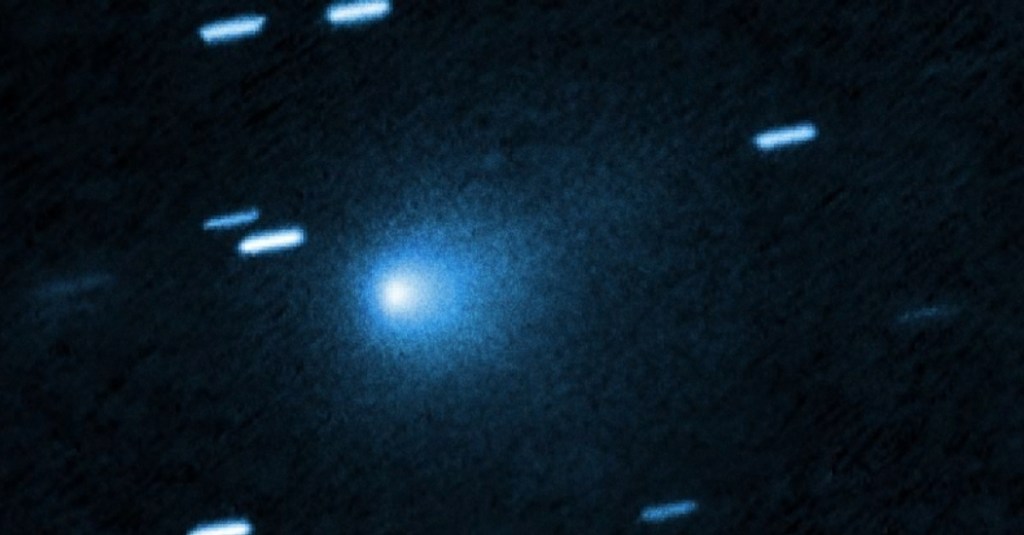Science
Astronomer Links 1977 “Wow!” Signal to Newly Discovered Comet

The mysterious “Wow!” signal detected in 1977 may finally have a potential source, according to astronomer Avi Loeb. This signal, captured by a radio telescope at Ohio State University, consists of a 72-second burst of radio waves that has intrigued researchers for decades. Loeb suggests that the recently discovered comet, designated 3I/ATLAS, might be the origin of this enigmatic signal.
On August 15, 1977, astronomer Jerry Ehman noted the unusual radio burst, circling the printout and annotating it with the word “Wow!” Despite extensive investigation, no similar signals have been recorded since, leaving the scientific community to speculate about its origins. Loeb’s theory, while controversial, adds a new dimension to the ongoing search for extraterrestrial life.
Loeb’s Hypothesis on 3I/ATLAS
3I/ATLAS, discovered earlier this year, is notable for being only the third known object to visit our solar system from interstellar space. Loeb theorizes that this object could be a technologically advanced spacecraft from a distant civilization. He analyzed the trajectory of both the comet and the signal, concluding that they originate from similar directions. He estimates the probability of this alignment occurring randomly is just 0.6 percent.
Despite the intriguing correlation, significant challenges arise when considering the feasibility of this theory. In 1977, 3I/ATLAS would have been approximately 600 astronomical units away from Earth, translating to around 55 billion miles. For the comet to have transmitted a signal across such a vast distance, it would have required a powerful transmitter, likely comparable to a nuclear reactor.
Moreover, there has been no detection of any signals from 3I/ATLAS by modern telescopes. Loeb has suggested that a dedicated surveillance effort, likened to a stakeout, should be undertaken to monitor the object for any potential signals that could affirm its extraordinary nature. He advocates for continuous observation, hoping to capture evidence that could confirm it as an alien artifact.
The Scientific Community’s Perspective
While Loeb’s excitement is palpable, many scientists emphasize caution. NASA scientists and other experts remain skeptical, leaning towards a more conventional interpretation of 3I/ATLAS as a typical comet exhibiting unusual behavior. The scientific principle of Occam’s razor suggests that the simplest explanation—rather than an alien origin—is likely the correct one.
This ongoing debate reflects the broader tension within the scientific community regarding the search for extraterrestrial intelligence. As researchers continue to explore the cosmos, the allure of the unknown remains strong, and theories like Loeb’s will undoubtedly stimulate further inquiry.
The implications of this potential connection between a historic signal and a recently discovered comet could reshape our understanding of both phenomena. As we look to the stars, the quest for answers continues, driven by curiosity and the desire to understand our place in the universe.
-

 Lifestyle3 months ago
Lifestyle3 months agoLibraries Challenge Rising E-Book Costs Amid Growing Demand
-

 Sports3 months ago
Sports3 months agoTyreek Hill Responds to Tua Tagovailoa’s Comments on Team Dynamics
-

 Sports3 months ago
Sports3 months agoLiverpool Secures Agreement to Sign Young Striker Will Wright
-

 Lifestyle3 months ago
Lifestyle3 months agoSave Your Split Tomatoes: Expert Tips for Gardeners
-

 Lifestyle3 months ago
Lifestyle3 months agoPrincess Beatrice’s Daughter Athena Joins Siblings at London Parade
-

 World2 months ago
World2 months agoWinter Storms Lash New South Wales with Snow, Flood Risks
-

 Science3 months ago
Science3 months agoTrump Administration Moves to Repeal Key Climate Regulation
-

 Business3 months ago
Business3 months agoSoFi Technologies Shares Slip 2% Following Insider Stock Sale
-

 Science3 months ago
Science3 months agoNew Tool Reveals Link Between Horse Coat Condition and Parasites
-

 Science2 months ago
Science2 months agoSan Francisco Hosts Unique Contest to Identify “Performative Males”
-

 Sports3 months ago
Sports3 months agoElon Musk Sculpture Travels From Utah to Yosemite National Park
-

 Science3 months ago
Science3 months agoNew Study Confirms Humans Transported Stonehenge Bluestones








